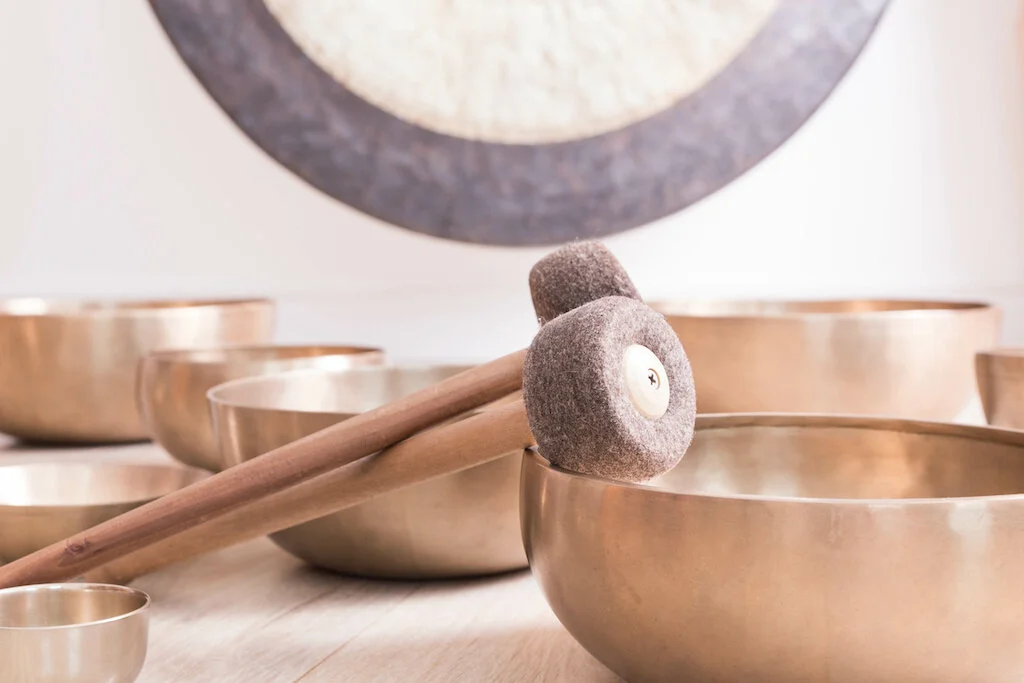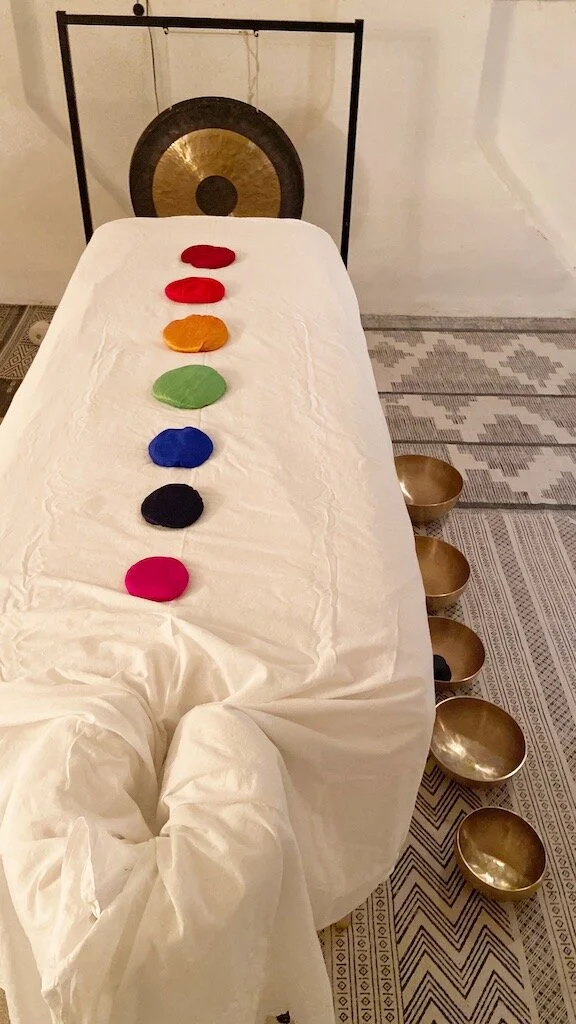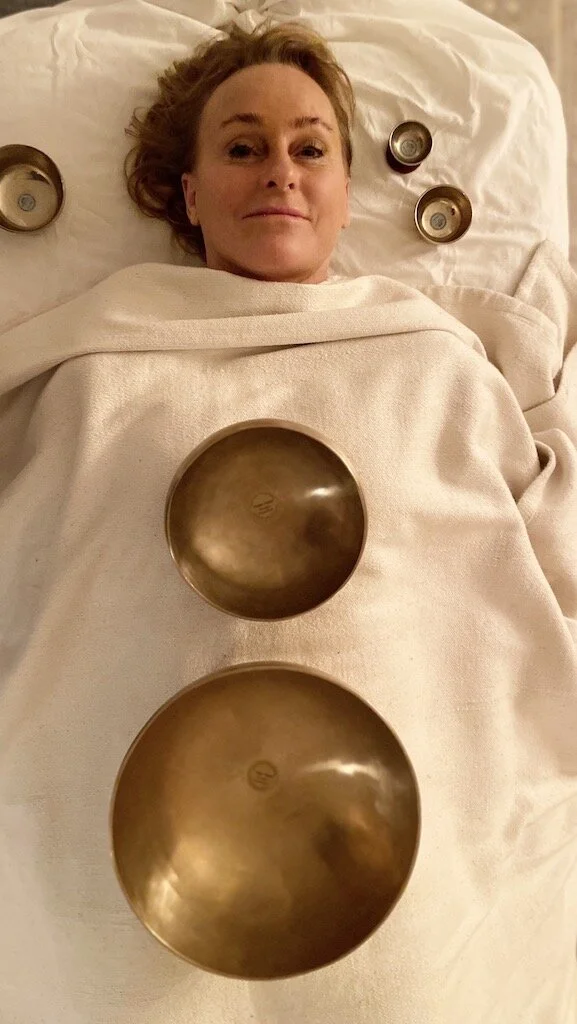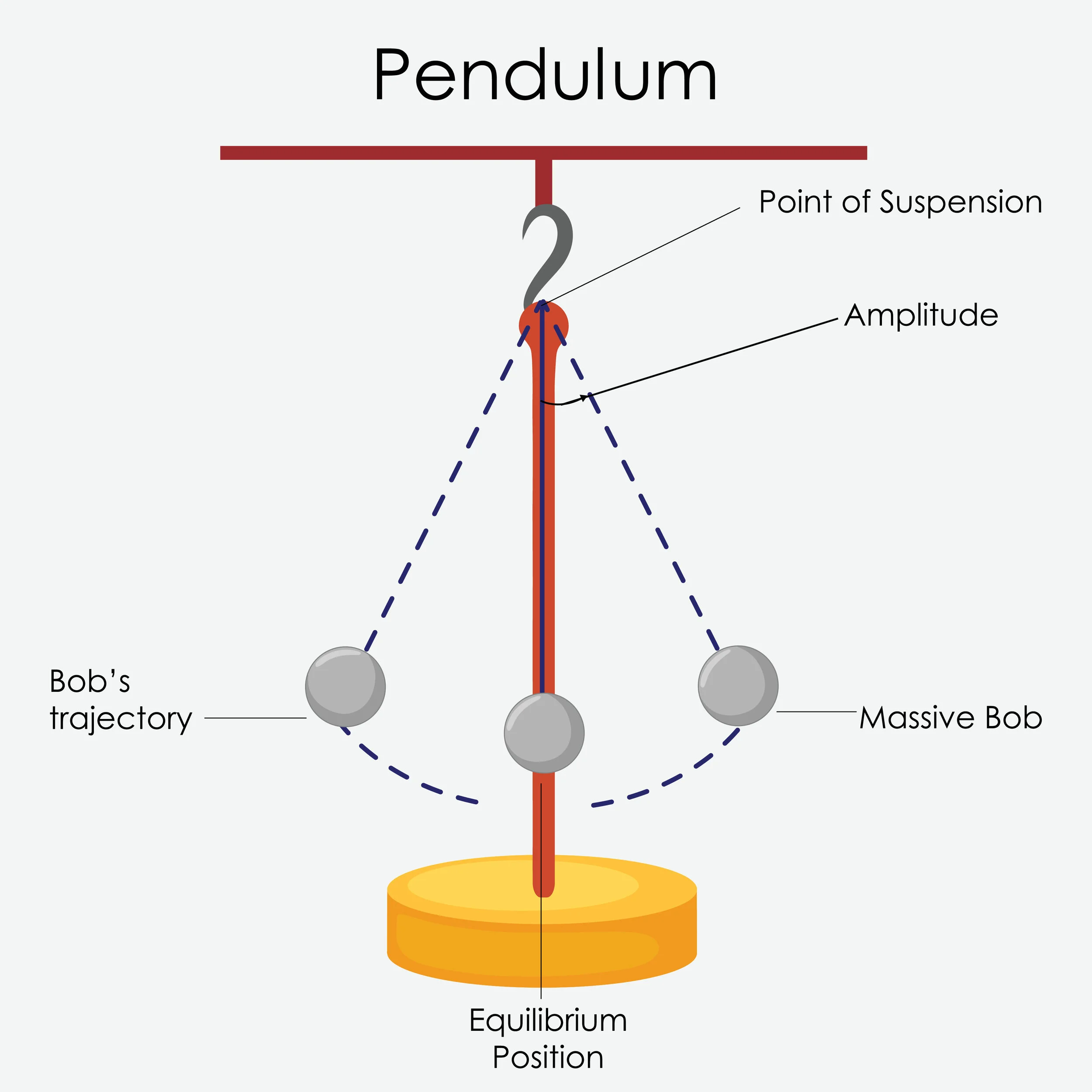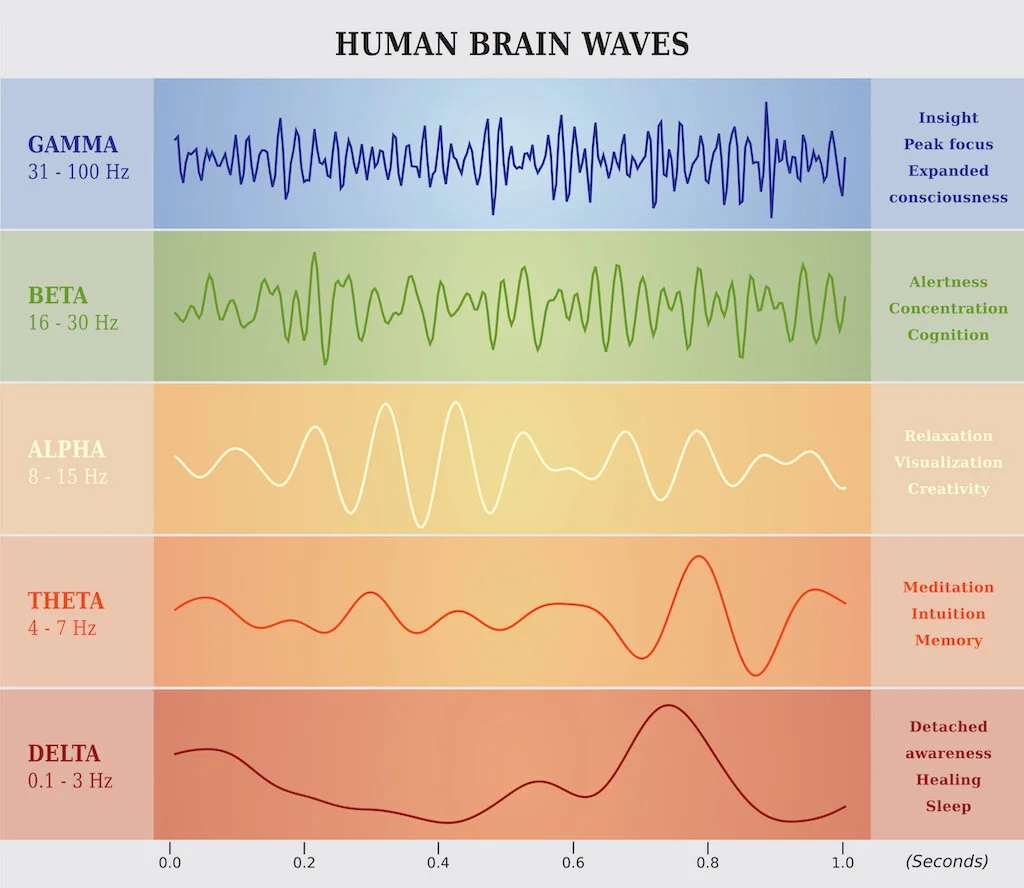How Sound Can Heal, Ease pain, and Relieve stress. All You Want to Know About Sound Massage, Sound Baths, and Tibetan Singing Bowls
This post contains affiliate links to products that I use myself or can recommend. You can read about my affiliate policy here.
"We must have reached the overture," I thought.
I was approx 45 minutes through my first sound massage treatment ever.
The sound massage therapist - Christina - gave the gong some proper strokes, then turned around and blew all the singing bowls placed on and around me. It triggered powerful vibrations and loud unrhythmic timbres that I could feel deep down in my bones. My logical thought amid this sound storm was that this couldn't be de-stressing to the body. Synchronously with that reflection, I also noticed that my body was in no way tense.
I was lying on my back on a massage table, fully clothed and wrapped in a blanket. Around my head were placed a pair of singing bowls (i.e., bronze bowls) the size of large teacups. A couple of slightly larger bowls was set on my chest - one or two-liter-sized bowls is my guess. On the floor around the table were placed several smaller bowls. Right at the end of my feet was a bigger bowl, and behind that hung a giant gong.
The treatment had started out gently with me lying on my stomach and Christina placing her hands calmingly on my back.
I was a little nervous, for starters. I'm always nervous the first time I'm trying something new - especially stuff that affects my body. I don't like losing control, so with a little increase in my heart rate, the first sound vibrations hit me right after those calming hands. Christina stroke a singing bowl at the foot end of the table, then had it touch both my feet - one foot at a time.
I felt the vibrations from the bowls all the way up my shins and calves.
Subsequently, with a twirling motion, she activated singing bowls on my bum and back. And like that, the treatment proceeded. Bowls on and around me were activated one by one. She lingered more in some areas of my body than in others, but she got through my whole system in just over an hour.
I went to sound massage therapy to get rid of some latent stress I'd felt in my body. And I've read that sound therapy is an effective tool to fight that.
I've been through some tough years as several people very close to me have been seriously ill, and my company has cost me lots of money and challenges. All that worry and pressure has hit deep in my system. So I've had few more body treatments than usual.
With that in mind, I'd jump on the table, not knowing that other latent things would show up.
“If you want to find the secrets of the universe, think in terms of energy, frequency, and vibration.”
It has taken me a long time to write this post because it's pretty difficult to find scientific studies on how sound and vibrations affect our cells and our body (beyond what you can find about ultrasound or construction workers' vibration injuries).
Treatments don't have to have been scientifically proven effective before I throw myself into it. No conventional studies don't necessarily mean that it doesn't work. However, I still always prefer to investigate how things affect us and why.
Sound healing has been used for millennia by most naturalists, so it must have worked on someone and on something. Otherwise, you would think they would've stopped using it at some point.
To understand how sound healing can have a healing effect, I started out with researching what sound is.
And sound is nothing but vibrations. But sound needs material to be able to travel. That means; no air, no sound. Sound travels about four times faster through water than through air.
The human body consists of approx. 60-70% water, and about 46% of that water is inside our cells. This means our cells and body can't really avoid getting affected by sound.
We also know that movement and massage stimulate the body's lymphatic system and detoxification processes - and sound is big-time movement.
Sound is, therefore, an obvious supplement to conventional treatment - not least for the treatment of stress. Because the thing that actually has undergone many scientific experiments is how singing bowls and other forms of sound therapy can reduce stress and tensions and give the mood a proper boost.
Contents
We start with defining what vibrations and sound are.
Then I briefly go into sound healing throughout history.
Next, a rant about how sound therapy can contribute to better health - body-wise, the nerves, and your state of mind.
At the bottom of this post, you'll find out about my bonus experience during my sound massage therapy.
Finally, I wrote an appendix for us nerds. If you'd like to know more about what frequency and resonance are.
What is Vibration
A vibration is a motion that gets repeated. For example, a swinging pendulum is vibrating because it swings back and forth repeatedly.
Everything in the universe, from microcosm to macrocosm, vibrates and is in perpetual motion because everything consists of atoms in constant motion.
Even solid objects like stones and steel vibrate constantly.
Depending on the speed of this motion, things will appear as a solid, liquid, or a gas. That is to say, even as something as presumably substantial as a building, is really more space between atoms than anything else.
“Everything in life is vibration”
What is sound?
Sound is waves that propagate through the air like rings in the water.
When you hit a drum, the vibrations from the drum cause the air molecules to bump into their neighboring molecules, which then bump into their neighbors, and so on. There is a progression of collisions that pass through the air as a sound wave. These vibrations enter the outer ear and cause the eardrum to vibrate too.
The eardrum sends signals/nerve impulses to the brain via the inner ear, which turns it into a sound that we recognize and understand.
These vibrations don't just hit the ear. They hit everything else nearby - and other vibrations as well. Vibrations from sounds also impact the physical body. Positively or negatively, they affect us physically, mentally, emotionally, and our consciousness.
Sound waves travel at different speeds depending on air pressure, humidity, and temperature.
Sound travels through air at 343 m/s (meters pr second)
As mentioned above, sound waves really speed up when they travel through other kinds of materials. When sound waves move through water, the speed is 1482 m/s; through wood, it's 4100 m/s. I have often noticed how much noisier traffic is when it rains..
Since sound is nothing but vibrations/waves in the air and a material thing, it affects its surroundings in many ways.
If you live next to a construction site or a nightclub, you know how much constant noises and vibrations can stress the body.
If you have been to a beautiful concert, you know how touching and edifying sound can be.
When you hurt yourself, you yell ouch, scream or cry because the sound relieves the pain (try to stay silent when hurt hits you. The pain will seem much greater).
Sound Healing Through History
Sound as a healing modality goes back thousands of years. Sound vibrations have been known to be the primary creative force in the universe.
Shamans chanted and drummed to heal people.
In the ancient mystery schools of Greece, India, Egypt, and other centers of knowledge, the use of sound and music for healing was a highly developed sacred science.
The Aboriginal people of Australia have used the didgeridoo as a healing tool for at least 40,000 years. Apparently, they could heal broken bones, muscle tears, and other kinds of illnesses using this enigmatic musical instrument.
In the 1930s, Western acoustic scientists discovered the healing properties of ultrasound, including its ability to crush kidney stones and reducing tumors.
Researchers began systematically studying the use of music in medicine and treating diseases in the late 19th century. Many studies show the positive effects of music on heart rate, respiratory rate, and blood pressure.
In the 1950s, when psycho-surgery was still legal in the United States, experiments on death row inmates' brains showed that stimulation of the front of the hypothalamus* with 70 millivolts of electricity triggered anger. But if soothing classical music was played while stimulating this part of the brain, the person would not show anger.
The Tibetan singing bowls (which, in fact, don't originate from Tibet) might be among the most ancient art craft in human history that still exists today. The technology to make them can be dated back to Mesopotamia for approx. 5000 years ago. A slightly different variation of the singing bowl can be traced back to the Himalayan region about 600 years ago. In addition to being used in households for storing food, water, fresh milk, etc., enlightened lamas and monks from Tibet and the surrounding regions used the singing bowls in teaching, to gain absolute concentration during the meditation, and to captivate spiritual energy. The Newari people of Nepal began using the sound and vibrations of the singing bowls for healing purposes a few hundred years ago.
*) The hypothalamus is a collection of nerves (a so-called ganglion) located in the anterior part of the midbrain. It controls many autonomic functions in the body, influences our emotions, and regulates the release of vital hormones
What is Vibrational Medicine?
As mentioned above, sound is vibrations, vibrations are waves, and waves transport energy. This is why sound can help with healing.
Waves, vibrations, and resonance are the "medicine" in sound healing and sound massage or vibrational medicine.
The human body vibrates too. Some theories claim that the human body has an optimal frequency, which is the state in which the cells in the body vibrate as they were designed to. You can use vibrations to reorganize structures and states. Vibration medicine claims to work on a deep, cellular level, where vibrations alter molecular qualities.
Ultrasound treatment is an example of a more conventional form of vibration medicine.
“The body is held together by sound, and the presence of disease indicates that some sounds are out of tune.”
What are Singing Bowls
Tibetan singing bowls are typically cast in bronze. An ordinary bronze alloy consists of approx. 90% copper and 10% tin.
The size of the bowls and the metal ratios affect the tone, the vibrations, and the sound quality. Singing bowls vary in shape and form as you use them in different ways and with various accessories depending on the purpose of the therapy.
The most common accessory is the wooden wool mallet or striker, with which you either strike the bowl or circle it around the rim of the bowl - always in a clockwise motion.
In addition to bronze bowls and gongs, pure crystal bowls have become increasingly popular for sound massage therapies, sound baths, and meditations.
What Are The Different Uses of Singing Bowls?
Singing bowls are primarily used during meditation practice to bring the user peace and calm and experience deep feelings of connection and release - ultimately bringing about a strong sense of wellness.
In addition to using them for meditation, singing bowls are typically used to achieve deep relaxation, muscle recovery and restore harmony and balance in the body.
THEY ARE ALSO OFTEN USED TO:
Relieve pain and headaches.
Improve circulation.
Release tensions or blockages.
Open to the energy flow.
Remove toxins from the body.
Better digestion.
WHEN WE RELAX TO THE SOUND OF TIBETAN BOWLS OR GONGs IT HELPS:
Improve our concentration.
Relieve our emotional tensions and blockages.
THE SOUNDS AND VIBRATIONS ALSO CLAIM TO:
Relieve mental or emotional pain (low self-esteem, worries, fears, anger, anxiety, depression, insomnia).
Stabilize blood pressure.
Ease Mild asthma problems.
Renew function of the adrenal glands.
Open and stabilize the meridians.
Improve the synaptic responses in our brain.
Help children with hyperactive disorders.
Stimulate the immune system.
The Healing Properties of Singing Bowls
Up to 90 percent of physicians' visits are stress-related, according to the American Institute of Stress. Of course, we all have stress, but it's how we handle the stress that matters most.
Stress, injury, and trauma pull cells out of their coherent structure. And if stress is not handled correctly, a complex web of disharmonies perpetuates - the whole "orchestra" is soon out of tune.
An out-of-tune body begins to experience various stress signals, including anxiety, insomnia, allergies, food sensitivities, or physical and emotional pain.
According to Buddhism and the above theories on vibrational medicine, these ailments and imbalances can be restored to a balance with proper soothing vibrations. Since everything in the universe is in vibration at its own pace, these external vibrations can alter the vibrations of matters and elements inside.
Cf. The science of resonance below ↓.
The basic idea is that the vibrations produced by the singing bowls affect and restore any out of harmony parts of our body and re-establish balance and health.
4 Ways Sound Massage Therapy & Sound Baths Impact Body and Brain
1. Water, cells, and detoxing
As mentioned in the introduction, our bodies and cells are composed of an incredible amount of water. Sound vibrations affect water; in this way, sound therapy supports the essential functions of the lymphatic system and the body's detoxification processes - our drainage systems.
Water also carries nutrients and oxygen to the cells, thus keeping our cells alive and healthy. Water aids in digestion and absorption of food. Water regulates body temperature and blood circulation and removes toxins and other wastes from cells and from our bodies.
The vibrations from sound therapy can help to harmonize any imbalances in these areas.
2. Ears, stress, and the vagus nerve
One of the reasons sound therapy has health-promoting properties is the way it affects the parasympathetic nervous system. The parasympathetic (calming) nervous system helps us deal with stress and keeps the body balanced (homeostasis).
Some branches of the vagus nerve stimulate the eardrum and the skin at the edge of our ear canals (concha). This means that any sound processed through the ears passes that information onto the vagus nerve (which is why some sounds can feel super stressful).
The vagus nerve is one of the most important elements in the parasympathetic nervous system, and it extends from the brainstem just behind the ears. It moves from there down on each side of the neck, across the chest, and down to part of the colon. It's the only nerve that connects the brain to the abdomen, digestive tract, lungs, heart, spleen, intestines, liver, and kidneys.
The parasympathetic nervous system is responsible for calming our organs after stressful "fight or flight" reactions. Therefore, the vagus nerve is also the key to controlling your state of mind and your stress level.
The vagus is made up of thousands of fibers, most of which are sensory. This means that the vagus nerve reports back to the brain about what is going on in organs, which is essential for our health.
An inactive or blocked vagus nerve is bad for our health, but by stimulating it with the right sound frequencies, you can help the body return to balance. Some studies show that singing bowls can positively impact stress, concentration, anxiety, mood, and muscle and bone pain.
3. Calming the Brain Waves
Something happens in the brain during a sound therapy session.
You can use different sound frequencies to "hack" the brain waves and promote healing processes in the body.
Brain neurons are constantly firing electrical impulses based on the data they receive from their surroundings. Neurons use small electric shocks to signal to each other. These are brain waves.
There are five widely recognized brain waves. The brain waves can be measured with EEG. EEG shows how the neurons signal to each other - how high the frequency is.
When we are awake and active, the frequency is high. When we go to sleep, the frequency lowers, and when this frequency is very low, the brain produces delta waves; at this stage, we experience the deepest levels of relaxation and restorative, healing sleep.
The primary frequencies of human EEG waves are listed in the table below.
Using specific sound vibrations, rhythms, and frequencies, can change the brain mode from beta to theta and even to delta mode. In the latter state, healing and recovery occur (note that there's still a lack of conventional research data here).
4. Music and the Brain's Neurotransmitters
According to neurophysiologist Manfred Clynes, music stimulates the limbic system with changes in neurotransmitters such as dopamine, endorphins, and growth hormone.
The Surprise Effect of My Sound Massage Session
I've had problems with my right hip and knee for many years. It comes and goes but never completely gone. It's a pain that often limits me in my workouts and yoga.
During my sound massage therapy session, I suddenly had the insight that my hip-knee imbalances stem from when I broke my knee at 14-year-old.
The fracture healed quickly, but the trauma is still in my system and unconsciously makes me protect my leg, putting more pressure on the other leg, thus creating an imbalance.
That thought never hit me before - that a healed injury 40 years ago still affects my mobility.
It was an essential realization for me. You quickly forget injuries and fractures as soon as you're healed. Still, traumas automatically leave traces in our survival system and should be processed to keep them from creating problematic, unconscious behavior.
Another thing I took with me from the treatment was that I biked home in the gray November weather in an incredibly good mood.
Those singing bowls sound and vibrations had noticeably lifted my mood.
I've booked another session.
Appendix
What is a frequency?
All things vibrate at their own frequency.
When you push the pendulum mentioned above, it will quickly begin to oscillate in its own natural rhythm - this is called natural oscillations, resonant oscillations, or natural oscillations.
Frequency is how many times the pendulum moves back and forth in one second. If the pendulum moves back and forth 5 times in one second, the frequency is 5 hertz (Hz) - frequency measured in hertz.
If you don't push the pendulum and just leave it, the width of the vibrations will lessen; although the width of the oscillations (the amplitude) becomes smaller and smaller over time, the frequency remains constant.
Frequency is independent of the push that started the pendulum.
When you hit a glass with a spoon, the glass produces a sound, aka the glass starts vibrating. Every time you hit the same glass with the spoon, it creates the exact same sound because the glass vibrates precisely at the same frequency every time the spoon hits it.
This is the natural frequency of the glass.
Again. All objects have their own unique, natural frequencies that they really like to vibrate on.
What is resonance, then?
Let's say that the above glass naturally vibrates at 1000 Hz.
If you place a speaker right next to the glass and the speaker makes a sound that also vibrates at 1000 Hz, the glass will immediately start vibrating. This is resonance.
Resonance is when you have an object with a certain natural frequency that starts vibrating because of an external vibration that has a frequency equal to the object's natural frequency.
If that speaker keeps producing that same frequency, the vibrations of the glass will increase until, at some point, the glass breaks.
The word resonance comes from Latin and means to "resound" - to sound out together with a loud sound. Resonance is a common phenomenon of sound production in musical instruments.
This phenomenon is also why soldiers break stride on bridges.
Although a bridge appears solid and immovable, it has a natural frequency of vibration within it. When you apply a force like 100 men walking in step, the sound waves begin to oscillate in rhythm and create resonance, and then there is a risk that the bridge steers together.
An interesting phenomenon occurs when different vibrating things/processes come into proximity: they will often start, after a little time, to vibrate together at the same frequency. They “sync up,” sometimes in ways that can seem mysterious. This is described today as the phenomenon of spontaneous self-organization.
Disclaimer:
All information in this blog is strictly for informational purposes only and should not be taken as medical advice. The statements made in this blog have not been evaluated by The Danish Health Authority. The products linked to in this blog and any information published in this blog are not intended to diagnose, treat, cure, or prevent any disease. The information provided by this blog is not a substitute for a face to-face consultation with your physician, and should not be construed as medical advice. The entire contents of this blog are based upon the opinions of Hanne Robinson. By reading and using this blog, you agree to only use this publication for personal informational use and not as a substitute for medical or other professional advice.
